Matador Network's Blog, page 703
February 11, 2021
How to ski at Bluebird Backcountry

“The depth hoar happens worst on the north-facing slopes,” Lucas Mouttet, Avalanche Program Director at Bluebird Backcountry, explained to a group of five students gathered for a Level 1 avalanche course in the snowy mountains of northern Colorado. “It also happens on the east face because there’s near-total shading, and then when it does heat, it facets.”
The avalanche training course, taught on site at Colorado’s newest ski area through a curriculum developed by the American Institute for Avalanche Research and Education (AIARE), provides basic risk assessment and travel planning skills to backcountry skiers and snowboarders venturing off-piste in the mountains. Technical terms like “faceting” and “depth hoar” are used on repeat in these courses, terms that — when properly understood — give backcountry users a basic understanding of when a slope is prone to slide, and why. (Hoar is a frost layer that can facet, or weaken, when the temperature warms.)
This is critical knowledge. Backcountry skiers are heading out this season in record numbers, a result of the COVID-19 pandemic’s impact on ski resorts and also due to the increasing prevalence of films, magazines, and social media posts documenting high-profile riders like Jeremy Jones, Elena Hight, and Chris Davenport ripping wide-open lines and tight couloirs on big, rugged peaks.
With no lifts, 1,200 acres of hike-to terrain, an additional 3,000 acres of guided-only “deep backcountry,” and a ski patrol dedicated to keeping both the terrain and the skiers safe, Bluebird Backcountry is the perfect segue from resort skiing to backcountry.
A ski area designed to educate and inform
Photo: Justin Wilhelm
Bluebird Backcountry, which is in its first full season operating at Colorado’s Bear Mountain outside the town of Kremmling, has deftly packaged the backcountry experience to make it more approachable and accessible to skiers and riders of all levels. In addition to established uphill routes known as “skin tracks” and a mapped system of gladed runs and bowls to ski down, Bluebird offers an extensive schedule of backcountry education classes and guided ski options to help beginner backcountry users transition from on-piste to off, and experienced users take that next step to riding bigger terrain, safely.
“Bluebird is unlike any other ski experience,” Co-founder Erik Lambert told Matador. “It feels different than a downhill area, nordic center, or traveling in the true backcountry — you kind of need to experience the vibe in person to understand.”
Bluebird offers both guided and unguided skiing and snowboarding with one big caveat: There are no lifts and no “cut” runs. The base camp area offers a solar-powered rental and welcome tent, seating areas warmed by fire pits, and a food truck that slings s’mores and beverages to toast after a long day. Beyond that, it’s full-on backcountry with few — if any — others around beyond your immediate crew.
“Bluebird is designed as a friendly and welcoming place for skiers of every ability and backcountry-experience level,” Lambert said. “Part of our mission is to make the backcountry more accessible to anyone who is curious and interested in learning … [W]e have plenty of slopes for guests of any experience level, including beginners, both uphill and downhill — skin tracks range from 200 to 1,200+ vertical feet, and downhill ratings span from green to extreme.”
The terrain is open Thursday through Monday, late December through late March. Those without their own gear setup can rent everything needed to ski in the backcountry, including avalanche gear such as a beacon, shovel, and probe.
Once equipped with gear, a staff member scans a skier’s day pass, which logs that the skier is leaving the base area and heading out onto the terrain. The skier then skins — that is, treks with “skins” on the base of their skis to prevent backward sliding — through an access gate that’s aptly labeled the “Mountain Portal.” From there, they select the trail they want to skin up and proceed on their way. Upon returning to the base area, staff scans the day pass again, marking the skier as safely returned; that way, no one is left unaccounted for at the end of the day. If a skier wishes to head back out for another run after returning to base camp, she simply needs to have staff scan her back out.
Terrain varies from beginner-level runs on Meat Hill, accessible in about 20 minutes of moderately strenuous ski touring, to expert chutes and steep runs accessed by a steep uphill skin on the Wapiti Way and Elkhide uptracks. Intermediate terrain is accessible on West Bowl, an open bowl with scattered trees, and the gladed Lost in the Woodwards, both about a 45-minute hike from basecamp. The big difference between here and other ski areas is that for each run you take, you must “earn your turns” by skinning to the top of it. A five-run day — easy when taking a lift to the top — is a rewarding but exhausting excursion at Bluebird.
Bluebird fills a big gap in Colorado’s ski industry
Photo: Justin Wilhelm
Bluebird is a welcome respite from the crowds of skiers along Colorado’s I-70 corridor. A busy day here sees 100 people on the slopes. Even with precautions, however, backcountry touring always poses a certain level of risk. Proper risk evaluation includes pulling the plug when something seems risky. Understanding this, according to Lambert, is a primary focus of Bluebird Backcountry.
“We evaluate and manage the snow similarly to ski patrol at any other ski area, and we offer the same reasonable expectation of safety to our guests,” Lambert said. “Our patrol team is intimately familiar with the terrain. We’re also conservative in our decisions to open and close terrain to ensure everyone has a great day out there.”
Bluebird offers three levels of backcountry education classes, recommended for entry-level users even before they sign up for formal avalanche safety training. Above those three levels, skiers can pursue official avalanche education courses like the class Mouttet was teaching in early February, through AIARE. Courses offered include both Levels 1 and 2 and the rescue drills course, meant to be taken between the two levels and on an ongoing basis as a means of keeping backcountry rescue skills fresh.
“We think of ourselves as an educational center, community hub, and a return to the roots of the ski industry, which has been a really fun combination for our guests,” Lambert said. “As more and more people choose to avoid crowds and seek solace in the backcountry, we offer a fun and relatively low-risk place to get started, evolve your education, explore a beautiful area, and generally have a blast on the slopes in a totally alternative way.”
How to plan a trip to Bluebird Backcountry
Photo: Justin Wilhelm
Bluebird also allows skiers and riders to sign up to “ski with a mentor,” which pairs them with a pro guide for the day for an educational touring experience. While Bear Mountain, West Bowl, and Meat Hill offer 1,200 acres of terrain, those who ski with a guide or sign up for an AIARE education course can access an additional 3,000 acres on the adjacent Diamond Mountain.
The first thing you’ll notice upon arriving and interfacing with the staff at basecamp is the humble, approachable attitude that should always be present in the backcountry. The ski area’s staff are avid backcountry skiers themselves, quick to offer tips on where to find the day’s best conditions or what the weather’s like at the peak. They’re also not shy about noting areas where conditions aren’t prime or that are closed for the day due to heightened risk.
If you plan to come, purchase a day pass ($50) online in advance. If it’s your first time, or if you’re coming alone, your best bet is to hire a guide to lead you to prime turns and the best snow. Remember that even though you’re at a designated ski area, big-mountain skiing always poses inherent risks. Skiing alone is not recommended.
Lodging is available in nearby Kremmling or Steamboat Springs, both within an hour’s drive of the ski area. You can also reserve a campsite at Bluebird and stay overnight in your RV or winterized van if you’re prepared with heating equipment and proper gear. 
The post Colorado’s newest ski resort was made to get you backcountry skiing appeared first on Matador Network.

Hans Christian Andersen museum

For fans of classic fairytales, Denmark is about to become an important stop on your itinerary. A Hans Christian Andersen museum is opening this summer in Odense, Denmark, the hometown of the famous author.
The new museum will use architecture, landscape, sound, and light to evoke the feeling of being inside his fairy tales. The site will be immense and feature a children’s house, an underground museum, and a magical maze-like garden.

Photo: Kengo Kuma & Associates,
Cornelius Vöge, +
MASU Planning
Henrik Lübke, the museum’s creative director, says, “Hans Christian Andersen’s artistic universe is fantastic, because it reverses how you imagine this world you thought you knew, but without putting anything else in its place. His fairytales do not point towards a universal truth, but rather into the open — towards the peculiarity and multiplicity of the world. In the new museum, we maintain this ambiguity by using Andersen’s own artistic strategies as the starting point for how the garden, the house and the exhibition have all been shaped, as well as for the many artistic contributions that will also be part of the museum.”
To create the museum, architects Kengo Kuma & Associates were inspired by the fairy tales themselves. “The idea behind the architectural design,” said Kuma, “resembled Andersen’s method, where a small world suddenly expands to a bigger universe.”

Photo: Kengo Kuma & Associates,
Cornelius Vöge, +
MASU Planning
Andersen, who died in 1875, is widely known for writing The Ugly Duckling, The Princess and the Pea, The Little Mermaid, and The Little Match Girl. 
The post An enchanting museum dedicated to Hans Christian Andersen’s fairy tales is opening this summer appeared first on Matador Network.

On scrod, New England's white fish
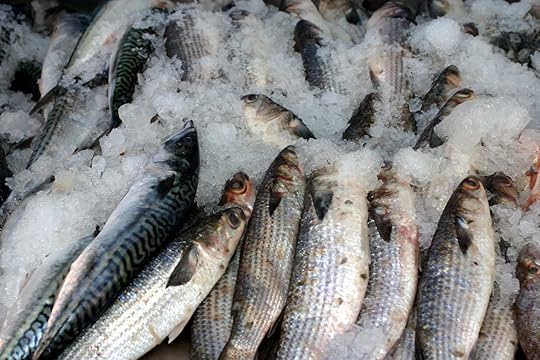
If you were to walk into Ninety Nine Restaurant in the Somerville neighborhood right outside Boston, you might see an unusual term in the description for New England fish and chips: schrod. Yet if you’re from Massachusetts, or the greater New England area, you won’t bat an eye. The term — or its alternate spelling “scrod” — is on restaurant menus all over the region. But if you’re from anywhere else in the US, the term might leave you scratching your head.
A few questions might pop into your head right away: What type of fish is scrod, actually? Why is it spelled that way? Where does the term even come from? Fair warning: If you venture to ask your friends from New England to help you interpret the term, you likely won’t get a definitive, or even consistent, answer.
What will be immediately clear, however, is that scrod isn’t a specific species of fish. Instead, it’s a general catchall term for many different types of white fish — usually haddock, hake, pollack, or cod. Scrod is not interchangeable with cod, and it does not indicate a specific species of fish (so you won’t find any scrod in the ocean). Just about everything else about scrod is debated.

Photo: Nikolay Dimitrov – ecobo/Shutterstock
To get to the bottom of why there’s so much discourse over what exactly the word scrod means, you first need to understand how important white fish — and cod in particular — is to the region’s economy, especially in Massachusetts. In 1798, people from Massachusetts marched to the newly built state house carrying a wooden replica of a cod as an homage to the fish that sustained the Massachusetts economy and ensured the survival of the mariners who explored the Atlantic, from Canada to New England, where the waters were “literally churning with codfish,” according to Mass Moments, a historical resource for educators. Now known as the Sacred Cod, the fish still hangs in the House Chambers of the Massachusetts State House.
Today, cod is still omnipresent on restaurant menus, but so is scrod, and both are of great importance to New Englanders. The most common origin story comes from the Omni Parker Hotel in Boston, which claims to have invented the term. Fishing boats that returned from sea to auction off their catch had the freshest, highest quality fish on top, while the soggy, older fish were packed into the hold. As New England Today tells the story, the hotel wanted the finest catch, but there was no guarantee that it would be cod, so the restaurant simply printed “scrod” on the menu as a convenient placeholder to identify whatever fish ended up in the kitchen that day.
This story is apocryphal: The original Omni Parker Hotel opened in 1855, but historians have discovered references to “broiled scrod” — a young cod browned on both sides and serve with butter and pepper — as far back as 1851 in a household manual called The American Matron; or, Practical and Scientific Cookery. Another cookbook from 1921 called The Boston Cooking-School Cookbook also defines scrod as young cod. The likeliest origins of the word, etymologically speaking, are from the Dutch scrood, meaning “small cut up pieces,” which would refer to the typical 19th-century preparation of salted and dried pieces of young cod. Its roots could also be traced back to the Cornish word scraw, which means to split, salt, and dry.
The Omni Parker Hotel’s story still resonates today, though, despite the fact that it’s been debunked — perhaps because New Englanders passionately cling to their own definitions of the word. An informal Twitter poll revealed competing ideas about how to properly deploy scrod. Multiple people stated that they thought the term was an acronym for “select catch ready on dock,” or “seasonal catch ready on dock,” whereas New England Living claims the true acronym is “select catch received on the day.” It’s perhaps worth noting that there’s no etymological basis for any of these acronyms, but they are nonetheless widely accepted today.

Photo: Fanfo/Shutterstock
Scrod seems to also refer to the way a white fish — whether it’s cod or not — is prepared. Seafood Sam’s, a seafood restaurant with locations in Falmouth and Sandwich Massachusetts insists that scrod should always be “split and deboned.” On Twitter, one person who grew up near Boston told me that scrod is always a “white flaky fish, usually baked with a coat of breading … sometimes with lemon too.” Another Bostonian backed up this claim, writing that in their house, scrod was served “baked [with] crumbled ritz crackers on top and a touch of lemon,” though the specific species of fish was never identified further. Someone else, who grew up in New Hampshire but spent time with their grandparents in Massachusetts, wrote that scrod is “generally in a baked dish or sautéed in lemon/butter/white wine.”
Should scrod refer to high- or low-quality white fish? Again there is disagreement. One Connecticut-based writer told me that her definition of scrod is “mild white fish … in some sort of buttery lemony preparation … fancy [but] in a very old-school, austere Yankee way.” And the legend propagated by the Omni Parker Hotel would also suggest that scrod is the freshest, highest quality catch. However, one Massachusetts native wrote that it should be “sold cheaply” while another referred to it with a rather more colorful acronym: “shitty cut of the day.”
What can we take away from these sometimes competing and confusing definitions? First of all, scrod is not its own species of fish, but rather it’s a general term for white fish that’s usually cod but not always. Restaurant menus still use the term scrod and probably won’t further identify the specific species of fish unless you ask. Whether or not it’s a cheap white fish from the bottom of the barrel is still in question.
It seems to be just a happy coincidence that scrod is a (near) portmanteau for “sacred cod,” and there’s no denying that cod is indeed holy to New Englanders. In fact, I think a consensus can easily be reached on at least one point: White fish, and cod in particular, ignites passion, enthusiasm, and excitement from people all over New England. To the rest of the world, scrod might be an odd-but-funny term that pops up on a list of specials every now and then. But in New England, it symbolizes a long relationship — and reliance — on white fish, both in its economy and cuisine. 
The post The legend of scrod, New England’s beloved white fish appeared first on Matador Network.

AutoCamp Airstream glampsites
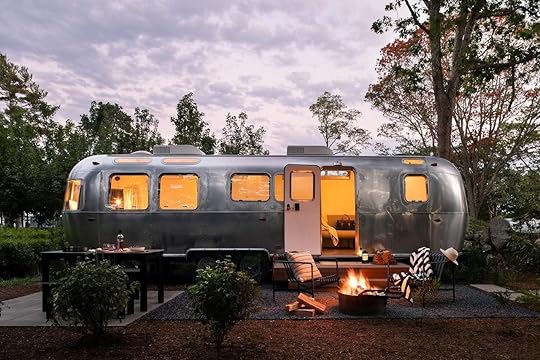
Good news, glampers: The high-end Airstream experience is coming to Joshua Tree, Zion National Park, and the Catskills. AutoCamp, the outdoor lodging brand that’s quickly become a favorite among outdoor adventurers who still like a little luxury, recently announced its plans to open three new properties later this year and in 2022. These locations will join the existing glampsites in Northern California’s Russian River, Yosemite National Park, and Cape Cod.
Coming this fall, the 25-acre Joshua Tree property will be the first to open with 47 Airstreams and the company’s first-ever outdoor bar, mobile kitchen, and joint hot tub and plunge pool, alongside various wellness experiences. Excursions within the national park are, of course, also available to guests, who can feel as good about where they’re spending their downtime given the brand’s commitment to sustainability and respect for the area’s cultural heritage.

Photo: AutoCamp
Designed with environmentally conscious features like solar panels, low-use-water plants, dark-sky-compliant lighting, and an on-site water treatment system, AutoCamp Joshua Tree will also come with a common area modeled on a traditional Quonset hut and decorated with artworks by local artists. Says CEO and Founder Neil Dipaola of the new expansions, “[They continue] to fulfill AutoCamp’s mission that is centered around creating a deeper appreciation for the outdoors through meaningful exploration and memorable adventures, all the while preserving the integrity and cultural significance of each destination.”
Glampers will have to wait a little longer to enjoy AutoCamp Zion National Park, slated to open in the spring of 2022, and the Catskills site. But if the reviews for the Russian River, Yosemite, and Cape Cod properties are anything to go by, we’re pretty sure they’re gonna be epic. 
The post Epic Airstream glampsites are coming to Joshua Tree, Zion, and the Catskills appeared first on Matador Network.

Epic Airbnbs in trending cities

We hope you love the spaces and stays we recommend! Just so you know, Matador may collect a small commission from the links on this page if you decide to book a stay, and listed prices are accurate as of the time of publication.
Airbnb has trending destinations that stretch across the globe.. From beach destinations to mountain getaways to urban hubs, they all have one thing in common: There are some epic places to rent in each one. Here’s the lowdown on where to find the best Airbnbs in the most popular destinations on the site.
Kaikoura, New Zealand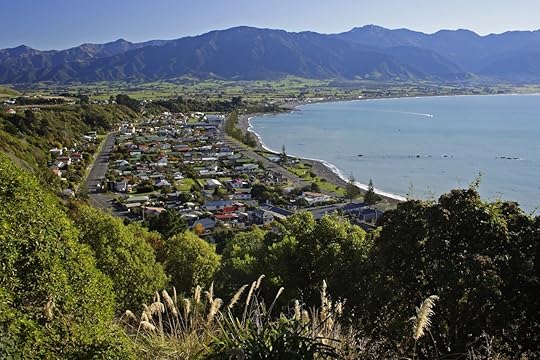
Photo: Sasapee/Shutterstock
The small south island town of Kaikoura is a household name nowadays but not for the right reasons. Kaikoura was badly hit by a 7.8-magnitude hurricane, and subsequent tsunami, in November 2016. Things are on the up now, though, and the country’s Coastal Pacific Railway just reopened after a two-year closure. You can contribute to the local rebuilding efforts with your tourist dollars by making Kaikoura part of a New Zealand itinerary. You likely won’t be alone. Year-over-year searches for lodgings in Kaikoura are up 210%, and Airbnb bookings are up nearly 300% since the tragic quake. If you’re up for making the journey that far down under, some stunning rentals are available.

Photo: Airbnb
Kaikoura has a range of rentals available, from trucks converted into tiny homes to a house with beer bottles built into the foundation. If rustic chic is more your style, there’s also this imported Mongolian yurt right on a farm where you can go watch and feed the animals.
Check out more listings in Kaikoura here.
Puebla, Mexico
Photo: Diego Grandi/Shutterstock
Puebla is the new destination in Mexico for those who want something a little different from the sun-seeking Mayan Riviera experience. Just a few hours drive from Mexico City, this large cultural hub was traditionally visited on a day-trip from the capital. Yet with a 206% increase in Airbnb users adding Puebla to their travel wish lists, things are about to heat up. Featuring colorful row houses, delicious food, and 365 churches, you won’t be short on photo-friendly settings. Plus, the regional Talavera pottery can be bought as a reminder of your time in the region. If you’re interested in history, make sure you add a visit to Cholula to your itinerary. It’s considered the oldest city in America.

Photo: Airbnb
Puebla is an incredibly cost-effective destination with comfortable accommodation available for around $50 per night — such as this beautiful apartment in a 17th-century building. To stretch your budget further, many lofts are also available to rent for around $30 a night.
Check out more listings in Puebla here.
Batumi, Georgia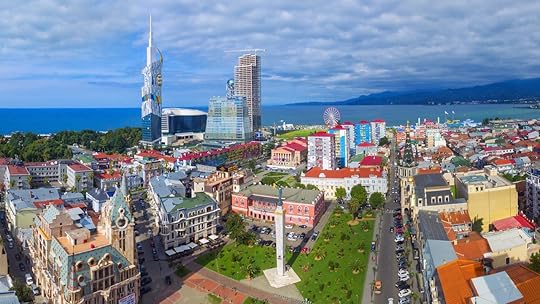
Photo: IgorZh/Shutterstock
While the last few years have seen a growing interest in Tbilisi, the capital of Georgia, 2019 is Batumi’s time to shine. This seaside resort on the Black Sea had long been a popular spot to vacation for members of the former Soviet Union. These days, it has a wider — and more Western — appeal. With a 200% year-on-year increase in searches for accommodation in Batumi, you’ll want to visit this emerging hotspot before it loses its local charm. There are only 160,000 permanent residents and lots of development, so make sure you check out the lively Old Town before it’s too late.

Photo: Airbnb
Despite its growing reputation as a resort getaway, prices for Airbnbs in Batumi are incredibly affordable. Seriously, where else in the world can you get a (nearly) beachfront apartment for less than $20 a night? On the other hand, if you’re looking for your very own piece of Soviet kitsch, this mansion house is suitable for up to 10 guests — and comes with an ornate indoor pool and some pretty awesome decor. What more could you ask for?
Check out more listings in Batumi here.
Normandy, France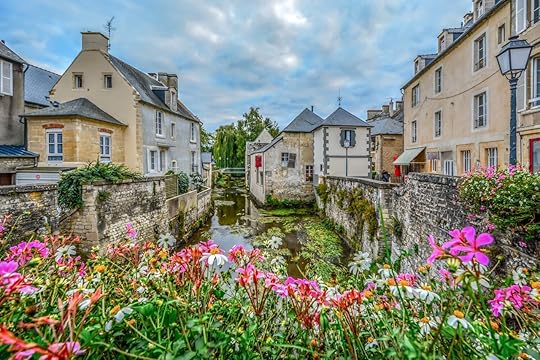
Photo: Kirk Fisher/Shutterstock
The coastal region of Normandy in western France has held a special place in the hearts of historians, being the location of the famous Normandy landings. 2019 will be the 75th anniversary of these landings and may be part of the reason that year-on-year bookings are up 229%. However, Normandy has a lot more to offer than war stories. The Normans have had an indelible mark on history, from the Bayeux Tapestry to the beautiful abbey of Mont St-Michel, with countless churches and cathedrals in between. With a laid-back pace of life and a selection of fine cheeses to boot, Normandy is your go-to for a peaceful getaway.
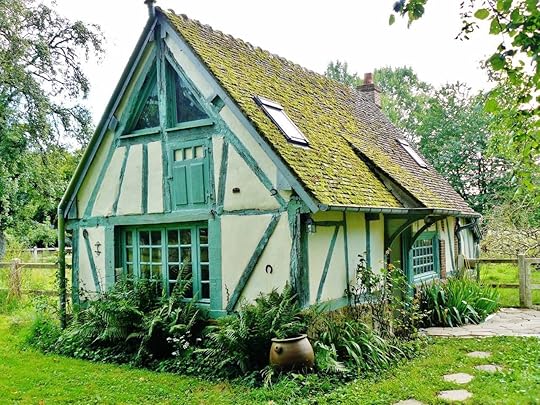
Photo: Airbnb
Normandy offers a spectrum of Airbnb possibilities. Whether you’re looking for a full-blown castle for you and numerous friends or something a little cozier, there are plenty of options — including homes near the famous coastline.
Check out more listings in Normandy here.
Xiamen, China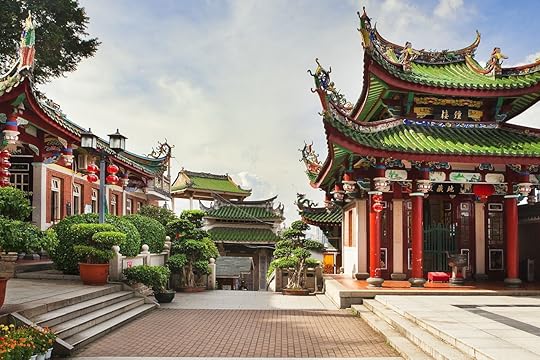
Photo: Marten_House/Shutterstock
If you’ve heard of this town in China, chances are, you’ve flown through it. Home to XiamenAir, the port city exhibits some of the charm of Old China, but many people flock to the city to see Kulangsu island. Deemed a UNESCO heritage site in 2017, it exhibits a fusion of architectural styles, combining sandy beaches with European-style mansions. Historically, it was an important site for Sino-foreign exchange. These days, you can pick up some delicious seafood on the traffic-free island, visit the world’s largest piano museum, or see some of its 600 heritage buildings. With a 283% increase in bookings through Airbnb over the last year, you won’t be the only visitors seeking a slice of Xiamen.
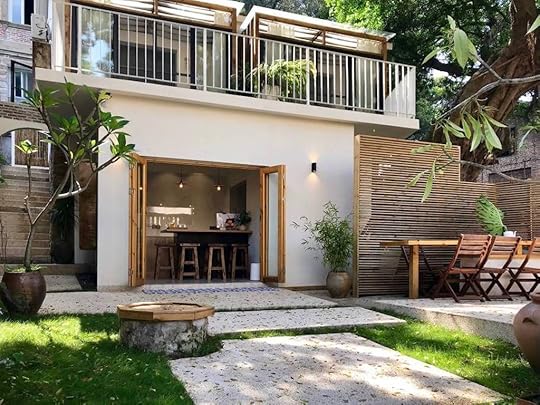
Photo: Airbnb
The good news is that Xiamen has a massive range of accommodations available. Whether you want a budget-friendly stay in the city or a gorgeous modern lodging on Kulangsu itself, there is something to suit everyone.
Check out more listings in Xiamen here.
Great Smoky Mountains, USA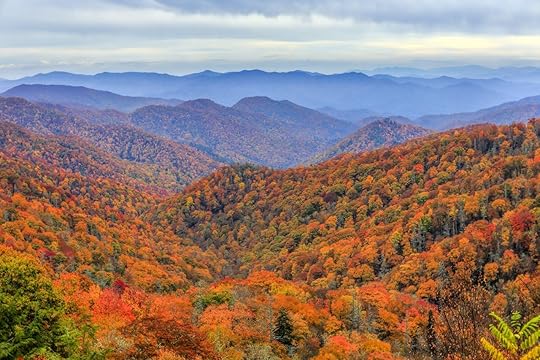
Photo: outdoorimages/Shutterstock
With a huge diversity of wildlife and some of the most beautiful waterfalls anywhere in the United States, the Great Smoky Mountains are the country’s most-visited national park. Originally established in 1934, the park — well known for its foggy mornings — consists of a long ridgeline of forest on the border between North Carolina and Tennessee. Whether you want to see black bears, wander the extensive forests, camp in the wilderness, or swim in a waterfall, the secret is out. Searches for accommodation in the area are up 190% year-on-year.
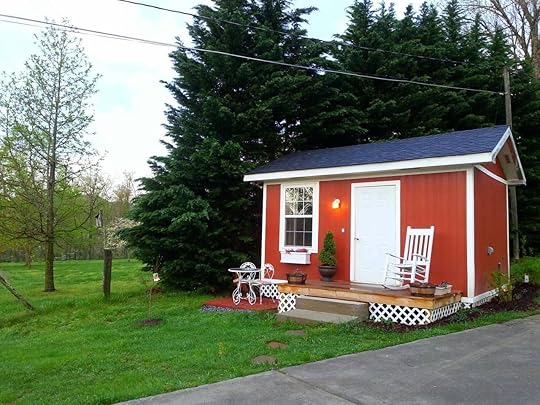
Photo: Airbnb
So make your plans and get out there. Whether you want to rent your very own tiny house or stay in something a little roomier, options abound.
Check out more listings in the Great Smoky Mountains here.
Uzbekistan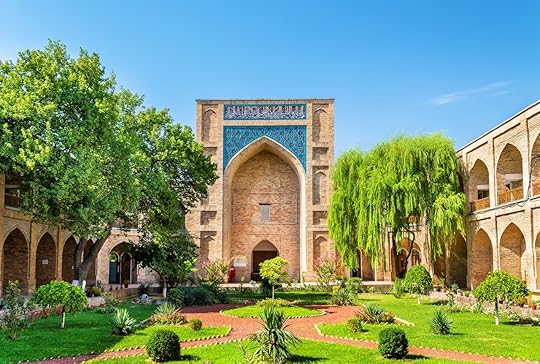
Photo: Leonid Andronov/Shutterstock
Another Silk Road destination that’s gaining a reputation is Uzbekistan, which last year loosened up its visa regulations. This resulted in a huge increase in travel interest. The country saw a 165% increase in wishlist additions on Airbnb. Khiva, Bukhara, and Samarkand were all important stops on the former trans-continental trading route. Tashkent, on the other hand, was completely destroyed in the 1960s and rebuilt in the typical Soviet style. Thanks to reasonable train connections throughout the country, a week’s stay can encompass several cities, meaning you can experience 12th-century mosques, towering minarets, and brutalist Soviet architecture all in one trip.

Photo: Airbnb
Airbnb is relatively new to Uzbekistan but has established an interesting range of options. If you dig deep enough, you’ll find some gems. Go for comfort in a beautifully appointed art studio in Tashkent or get your Yurt on in the Kyzylkum desert for a true Uzbek experience.
Check out more listings in Uzbekistan here.
Taiwan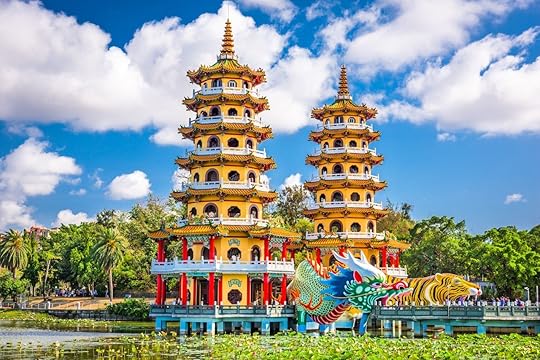
Photo: Elena Stepanova/Shutterstock
Although Taipei retains its perpetual charm, travelers are starting to look beyond Taiwan’s capital city to the rest of the island. There’s definitely something in the water with a 100% increase in wishlist addition for the Taiwanese provinces over the last year. Whether it’s visiting the beautiful old street in Daxi in the Taoyuan region, with its traditional storefronts, or trying tasty tofu delicacies, the lesser-known provinces of Taiwan have a lot to offer. Taitung, a sleepy coastal town, is another popular choice, offering a beautiful array of scenery and outdoor adventures including being a surprisingly exhilarating surf hotspot.
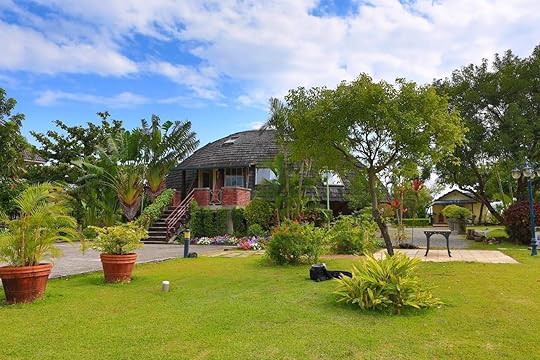
Photo: Airbnb
In Daxi, you can chill out in a traditional Taiwanese Minsu complete with a comfortably large bed and an epic balcony view — and your hosts can even help you whip up a mean kiln-baked pizza. In Taitung, you can stay in the unique UFO house and grab a bike to explore the local fields surrounding the property.
Check out more listings in Taiwan here.
Accra, Ghana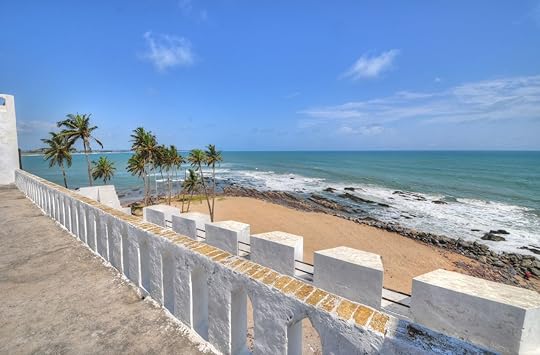
Photo: Felix Lipov/Shutterstock
Speaking of surfing hotspots, did you realize that Accra is one of the best surfing destinations in Africa? With a 163% increase in bookings here, the capital city of Ghana, a few people have apparently figured it out. This destination on the West African coast is not for everyone. Its sticky, heaving streets have been known to tire even the hardiest of travelers. For those willing to stick it out, though, you’ll have an experience to remember. Whether it’s checking out the aforementioned beaches, local seafood delicacies, or thriving fashion scene, this city certainly never sleeps.

Photo: Airbnb
If you’re looking for a gorgeous designer property to rent, you’re in luck. This amazing home — at less than $110 a night — includes breakfast each morning in tranquil surroundings. If you’re looking for something a little more personal, you can stay with the friendly Gidi and Gladys in their family homestay, complete with pet rabbits and assorted birds.
Check out more listings in Accra here.
Wakayama, Japan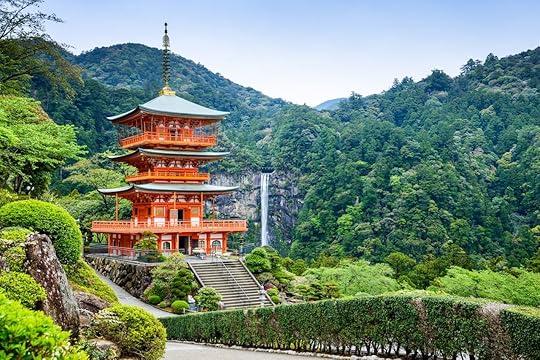
Photo: Sean Pavone/Shutterstock
If you’re keen on ramen, you need to visit the Wakayama prefecture in Japan, just an hour from Osaka. Ide Shoten’s Wakayama ramen was once voted Japan’s most delicious store, and the city has seen a spate of visitors ever since. Maybe that’s why the city has seen a 128% rise in year-on-year bookings. That said, the increase could also be due to Wakayama’s stunning scenery, which includes the Kumano Kodo hike. The hike was originally a pilgrimage route that led to three major Japanese shrines: Hongu Taisha, Nachi Taisha, and Hayatama Taisha. If you’re into experimental cuisine, you can even have a go at cooking your egg in the local onsen (hot springs).
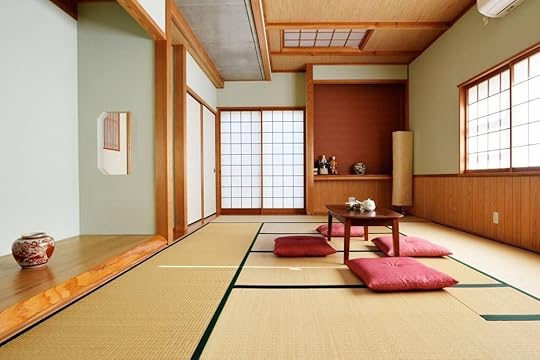
Photo: Airbnb
Airbnbs in Japan tend to be of the traditional (read: spartan) variety, but there are a few variations on this theme. This beautiful homestay includes an organic breakfast and dinner each day and is set amongst mountain terraces. For a luxury experience, this beachfront house on the border of South Osaka and Wakayama (sleeping 14) should fit the bill.
Check out more listings in Wakayama here.
Buenos Aires Province, Argentina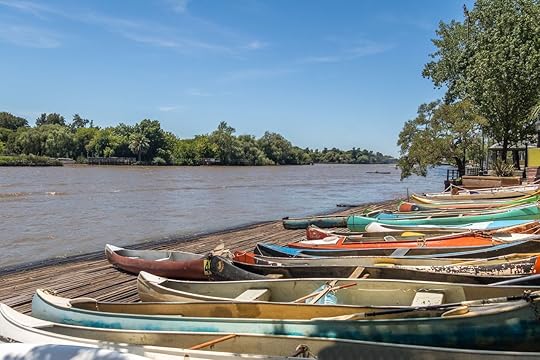
Photo: Diego Grandi/Shutterstock
We’re not talking about the famous Argentinian city but rather the province spanning the Atlantic Coast, which is becoming increasingly popular with Airbnb users. With bookings up 188% year-on-year, the province offers a variety of scenery, from mountains to sea, along with the activities that each landscape offers. Many travel to visit the Paraná Delta from the city of Tigre. Meanwhile, the beach region — stretching from San Clemente del Tuyú to Carmen de Patagones — attracts millions of primarily domestic tourists each year. With the peso losing value against the US dollar, Argentina offers a cost-effective destination with delicious wine and food to boot.
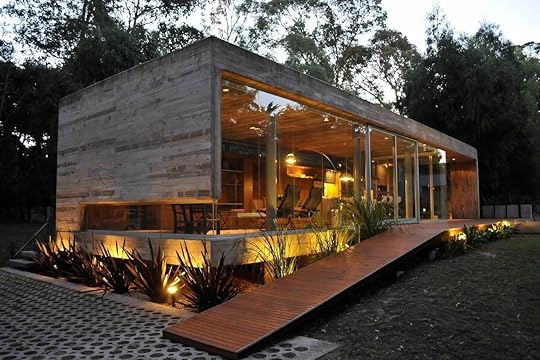
Photo: Airbnb
Architectural delights abound in Argentina, and this beautiful minimalist wooden home is no exception. If you’re looking to get back to nature, this eco-cabana should fit the bill — but still includes the comfort of air-con and Netflix, of course.
Check out more listings in Buenos Aires Province here. 
A version of this article was previously published on January 8, 2019, and was updated on February 11, 2021, with more information.
More like thisWhere to StayThe 11 dreamiest Airbnbs in ItalyThe post The most epic place to rent in Airbnb’s most trending destinations appeared first on Matador Network.

February 10, 2021
Massachusetts' state dinosaur

Massachusetts’ choice for president was never really in doubt this past election. A much more unpredictable election, however, recently took place in the state, with consequences that will last far longer than four years. In an initiative launched by dino-nerd and state representative Jack Patrick Lewis, Massachusetts is currently voting on an official state dinosaur. There’s already a state flower (the Mayflower, also known as trailing arbutus) and a state bird (the black-capped chickadee) — the only thing missing has been a dinosaur.
“I was unprepared for the excitement that this project would generate,” Lewis said. “My hope continues to be that this project will help young people better understand the prehistoric world and career opportunities that might grow out of a childhood interest or a love of science.”
Lewis, a lifelong dinosaur enthusiast, wanted to come up with a way to get kids in his child’s Cub Scout den engaged in paleontology. Introducing a bill to name a state dinosaur seemed like the best way to do it.
Throughout January, Massachusetts residents voted on the state dinosaur and chose Podokesaurus holyokensis — a species discovered through fossils near Mount Holyoke in 1910. Also known as the “swift-footed lizard,” P. holyokensis was a small, carnivorous dinosaur (smaller than three feet long) that lived in the USA between 195 and 180 million years ago.
In early February Lewis introduced two bills with the goal of appointing P. holyokensis as the official state dinosaur. Massachusetts has become the 13th state to name an official dinosaur. 
The post Massachusetts just elected an official state dinosaur appeared first on Matador Network.

Traditional Indian desserts

In India, no occasion takes place without desserts. A dessert is served at celebrations from birth to death, and religious feasts and festivals are big on sweets.
Traditionally, a homemade dessert was a must after every Indian meal, though a piece of jaggery (a brown sugar from palm tree sap) was offered if a full dessert was absent. Desserts like rice kheer are mentioned in ancient Sanskrit texts of India. They’re offered to deities and form an integral part of Hindu festivals. Desserts like phirni, a must in Ramadan feasts, have Persian origins while the multi-layer cake bebinca, a favorite during Goa’s Christmas, has Portuguese influence. Foreign invaders, settlers, migrants, and traders have all contributed to the smorgasbord of desserts India has.
Today, Indian desserts are usually made of milk, sugar, lentils, jaggery, coconut, and cereal grains, but the exact type of dessert served depends on what part of India you’re talking about.
There are few common pan-Indian desserts, and there are as many options as are there are different communities, cultures, religions, and geographical regions in the country. Every region, and in some cases every town, boasts its own dessert or a local version of a common one. Visit any old lane of a city and you’ll find the traditional sweets maker, called a halwai, deep frying a sweet or stirring a kadhai (a type of deep cooking pot) full of milk.
These 10 regional Indian desserts will satisfy any sweet tooth.
1. Kheer
Photo: Indian Food Images/Shutterstock
Kheer is one of the most ancient Indian desserts, and it’s found all over India with some regional variations. A sacred dessert, a festive dish, a fasting food, or an occasional indulgence at home, it’s easy to make and delicious to eat. It’s made by boiling milk and then adding an aromatic rice variety and simmering in low heat until the mixture thickens. It’s then garnished with bits of dry fruits and cardamom powder and viola: a no-fuss fragrant and sumptuous dessert is ready.
Depending on the region, the rice could be replaced with sooji (semolina), phool makhana (foxnut), sabudana (made with tapioca roots), or even grated carrots and lauki (a type of bottle gourd). Kheer made with short cut vermicelli noodles called seviyan (or sometimes semiya payasam) is a must during the Muslim festival Eid. Parsis in India make kheer with a hint of nutmeg that’s known as doodh pak.
India’s northeast state of Manipur produces the finest black rice, chakhao amubi, and kheer made of this black glutinous rice is a delicacy there.
In south India, kheer is called payasam and is served during celebrations or momentous events. It is rich and creamy, with the most traditional preparation replacing milk and sugar with coconut milk and jaggery, a truly vegan dessert. During the Hindu festival Pongal, recently harvested rice is boiled in milk with jaggery, and the Onam festival in Kerala features kheer in a festive feast called sadhya.
2. Pitha
Photo: Susmita Dutta Saha/Shutterstock
Rice is the staple food of India. The cereal grain is used to make a traditional, sweets-filled rice flour dumpling dessert called pithas — especially in the rice-producing regions of east, central, and south India.
Pithas are steamed rice flour dumplings filled with a sweet stuffing like jaggery, coconut, til (sesame), khus khus (poppy seeds), and mawa (dried whole milk), among others. They’re commonly prepared during the rainy season and winter. During the harvest festival of Makar Sankranti on January 14, Bengal’s version, called bhapa pitha, and doodh puli pitha (dumplings in milk) are a delicacy. In the northeastern state of Assam during the harvest festival Bhogali Bihu, pithas are a pancake of sticky rice stuff with til and jaggery.
During the popular Ganesh Chaturthi festival in the western state of Maharashtra, steamed pitha known as modak is stuffed with jaggery and freshly grated coconut and offered to Lord Ganesha. In Kerala, a similar pitha known as kozhukattai is made during Easter by Syrian Christians.
3. Pua and malpua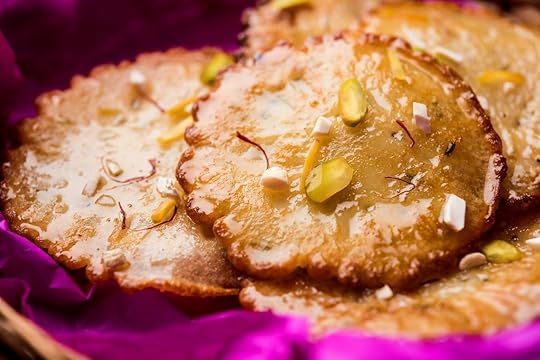
Photo: Indian Food Images/Shutterstock
Pua are discs of deep-fried sweet pancakes that are soft on the inside and crispy on the outside. They’re made with maida (refined white flour). Pua are mentioned in the ancient Veda text as apupa, where they’re made of barley flour sweetened with honey.
Pua is a popular dessert during the Holi festival in the states of Bihar and Uttar Pradesh. It’s also a common temple offering. It can be made in several ways: dry, ras pua, malpua, or chhena pua.
Dry pua has sugar mixed in the batter of milk, maida, and mashed banana, and it’s fried on low heat. Ras pua is soaked in sugar syrup after it’s fried, while malpua is rich in dry fruits or nuts. Malpua is an indulgent dessert with lots of dry fruits and eggs in the batter. It’s eaten during iftar (breaking fast) during Ramzan leading to Eid-ul-fitr festival. The sizzling malpuas of Mohammad Ali Road in Mumbai are famous.
Chhena (cottage cheese) malpuas are found only in Rajasthan. Pushkar in Rajasthan is synonymous with malai malpua, which is topped with raabdi (a sweetened milk) and found in lanes around the Pushkar lake. In eastern state of Odisha, malpua is a popular street food.
4. Phirni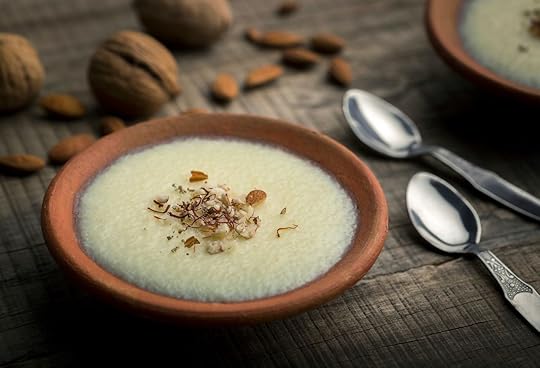
Photo: Prabhjit S. Kalsi/Shutterstock
Associated with the Muslim festivals of Eid and Ramadan, phirni is a popular dessert in north India and is still found in the winding lanes of Delhi and Lucknow. It’s made with fine basmati rice that’s coarsely ground and simmered in whole milk and flavored with cardamom, rose water, and saffron. It looks royal garnished with slivers of almonds and pistachios and vark (silver leaf).
Phirni is served in earthen cups called sakora or mitti ki kasoor that soak up any excess water and lend an earthy fragrance. The mildly sweet, thick, creamy, and grainy dessert melts in your mouth when served chilled. It’s a grand finale to heavy Mughlai meals or biryani feasts.
It is wildly speculated that phirni came to India from Central Asia prior to, or with, the Mughal invaders from the northeast. Similar milk-based dishes are still popular in Central Asia, and phirni was a regal dish relished by the Mughals.
5. Halwa
Photo: mirzamlk/Shutterstock
Halwa, or halva, is a sweetened flour, ghee, and jaggery dessert that’s very popular all over India. It’s even served as a special treat for hard-working government workers: During the halwa ceremony, the country’s government finance workers are presented with a massive bowl of halwa.
Halwa seems like it’s endlessly customizable. Halwas can feature anjeer (fig), badam (almonds), kaju (cashew), doodhi (bottle gourd), besan (chickpea flour), sohan halwa (mawa and dry fruits), Bombay halwa (transparent cornflour halwa), and mandua ka halwa (ragi) to name a few.
Halwa is also a divine offering in temples and gurdwara (a place of worship for Sikhs). Sooji ka halwa (made with semolina) is a common offering during the Navratri festival. In Sikhism, a halwa made with wheat flour called kada prasad holds divine significance. Sooji ka halwa is also turned into an anytime dessert with dollops of ghee, sugar, and dry fruits. Moong dal halwa made with yellow mung lentils are popular in Rajasthan, and gajar halwa made with carrots is delicacy of north.
6. Laddu
Photo: Sanoop.cp/Shutterstock
These sweet balls made of flour, fat, and sugar are a must-buy from every sweet shop. The versatility of laddu, also sometimes spelled ladoo, makes it special. It can be made of a variety of ingredients, which can change depending on the season or event. The name of the dessert is related to joy of all kinds: To any good news, people will say, “laddu baato” (distribute laddus).
Til ka laddu (roasted sesame and jaggery) is made in the winter during the Makar Sakranti festival. Other warming laddu that are common in the colder months include panjiri ki laddu (a mixture of foxnut, semolina, wheat flour, and dry fruits), sonth aur methi ka laddu (dry ginger and fenugreek), and gondh ka laddu (edible gum resin). The sonth methi laddu is traditionally given to lactating mothers.
Like some of the other desserts on this list, laddu are also common offerings in temples — particularly besan (ghee and cardamom), motichoor (smaller laddu), and nariyal (coconut) laddu. Then there are the crispy and crunchy murmura (puffed rice) and chura (flattened rice) laddu.
Some temples’ claims to fame are not only the revered deities but also the laddu prasad (offering) they have. The laddu of Tirupati temple and Shirdi and Sankatmochan (in Varanasi) are delicious.
During COVID-19, many sweet shops started making Ayurveda-based laddu of different herbs and seeds, selling them as immunity booster laddu like the Muesli-Ashwagandha laddu.
7. Rasgulla
Photo: CKP1001/Shutterstock
Rasgulla, a round ball of chenna (cottage cheese) that’s dunked in a light sugar syrup, is a much-loved dessert in eastern India. If you pop one in your mouth, it oozes with sweetness, and British colonizers were extremely fond of the sweet.
The dessert’s origins are a bit hazy. One story is that Nobin Chandra Das, a Kolkata confectioner, invented rasgulla in Bengal in the 19th century, though the state of Odisha disputed it. The rasagola (in Odiya) had been offered as bhog (food) to the Goddess Lakshmi in the revered Jagannath temple in Odisha long before that.
Bengal’s rasgulla is soft, spongy, and chewy while the Odisha one is soft and not chewy. Rasgulla made of chenna and nolen gur (palm jaggery) is a winter specialty of Bengal. All versions of rasgulla are delectable desserts.
8. Kulfi
Photo: StockImageFactory.com/Shutterstock
Kulfi is India’s version of rich and creamy ice cream. It’s made by heating milk over a low flame until it thickens, and then is left to cool.
Traditionally this reduced milk was mixed with nuts (typically almonds and pistachios), sugar, and cardamom or saffron for flavoring. It was poured in kulfi moulds and placed inside a matka (earthen pot) filled with the ice and salt mixture. This resulted in fast freezing and a delectable smooth kulfi. These are served dipped in raabdi (sweetened milk) or cut in circular discs.
The available flavors today include mango, kesar-pista, chocolate, custard apple, and even paan kulfi made with betel leaf.
9. JalebiIf you’re hit with a heady sweet smell while walking down a street in India, chances are that you’re smelling jalebi dunked in sugar syrup and served hot. Made of a fermented wheat flour called maida and a yogurt mixture that’s then fried, jalebi-making is an art. It’s often accompanied with raabdi to make a delicious dessert. Other popular types include chenna jalebi with cottage cheese and a version popular in central India that’s shaped into a spiral called mawa jalebi.
10. Bebinca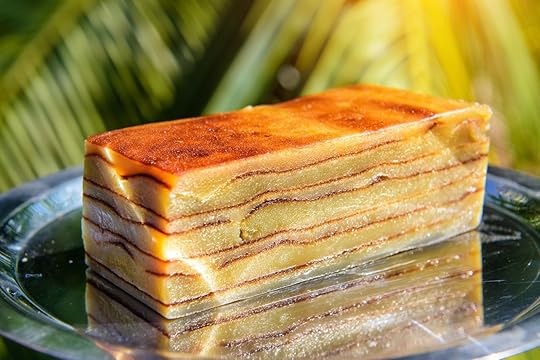
Photo: exebiche/Shutterstock
Known for its sun, sand, and beaches, Goa has a strong Portuguese influence in its culture and cuisine. One of the most popular Goan-Portuguese desserts is bebinca (also known as bibik), which is a multi-layer cake made during Christmas, Easter festivals, and on any celebratory occasion. It’s a rich, decadent, and gooey dessert made with lots of ghee, flour, eggs, sugar, and coconut milk.
Though the ingredients are simple, it takes immense patience to make. A minimum of seven layers are baked one at a time before adding the next layer. The slow cooking helped earn bebinca the moniker “the queen of Goa” desserts.
Bebinca was created during the 17th and 18th centuries. The Portuguese ruled Goa during that time, and legend has it that one of the nuns from the convent of Santa Monica invented bebinca. The nuns used egg whites to whiten their habits, which left them with a lot of yolks. So they whipped them with flour and created a new dessert. 
The post 10 delectable Indian desserts anyone with a sweet tooth will love appeared first on Matador Network.

NYPopsUp theater pop-ups

Broadway isn’t coming back just yet, but New York is taking steps to revive live theater with a new initiative called NYPopsUp. In a Monday press conference, New York Governor Andrew Cuomo announced a plan to kickstart theater for the first time since March 2020, with pop-up events featuring surprise live shows with stars like Hugh Jackman, Renee Fleming, Sarah Jessica Parker, Patti Smith, and Kenan Thompson.
At the news conference Cuomo said, “When you shut down Broadway, when you shut down movie theaters, you stop an entire industry. Everybody understands why, but we have to now nurture that industry to bring it back. It is vital for our cities to survive. The arts industry workers — many of them have been out of work since March. So, we’re going to accelerate that reopening with 300-plus pop-up art events all across the state — 300 events in 100 days of pop-up performances.”
NYPopsUp is designed to boost the city’s morale through live performances. Because massive crowds still aren’t permitted, the shows will not be pre-scheduled or announced. You’ll just have to get lucky and show up in the right place at the right time.
“We’re trying to thread the needle,” said Cuomo. “We want the performances, we don’t want mass gatherings, we don’t want large crowds, so pop-up performances that will surprise people and bring the arts back.”
The pop-ups will occur not just in New York City but across the entire state. The first performance is the only one that’s actually scheduled and will take place on February 20 at the Javits Center as a tribute to healthcare workers. The lineup for opening weekend will feature Jon Batiste, Ayodele Casel, Anthony Roth Costanzo, Cecile McLorin Salvant, and others, as well as a procession from Walt Whitman Park to Golconda Skate Park.
The pop-ups are expected to run through Labor Day. 
The post Surprise live theater shows are coming to New York featuring Hollywood’s biggest stars appeared first on Matador Network.

What is Losar, Tibetan New Year
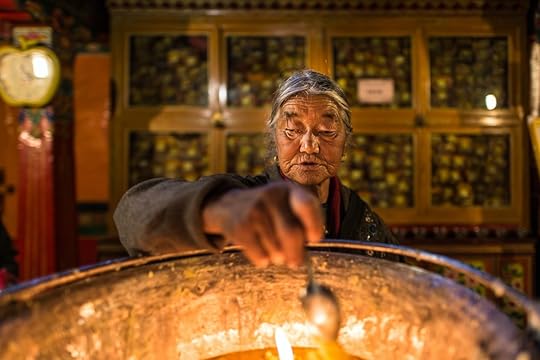
Grotesque masks and bright costumes, prayer flags waving in the breeze, multi-colored butter sculptures, and thousands of butter lamps lighting up the night are all key parts of Losar, the Tibetan New Year festival. Over a couple of weeks, the people of Tibet (and some from Nepal, Bhutan, and India) take part in ancient ceremonies that honor the gods and spread love and blessings to those dear to them for the new year ahead.
What is Losar and how did it start?Losar is a 15-day New Year celebration observed by Tibetans (as well as some people from Nepal, Bhutan, and India) around the world. The festival’s main events occur on the first three days, followed by informal gatherings with family and friends and culminating on the 15th day with the Butter Lamp Festival.
Losar began as a winter incense-burning ceremony of the indigenous Bon religion, which predates the arrival of Buddhism in the country. When Buddhism made its way to Tibet, the holiday became a way to celebrate the new year and was moved to coincide roughly with Chinese New Year.
Losar traditions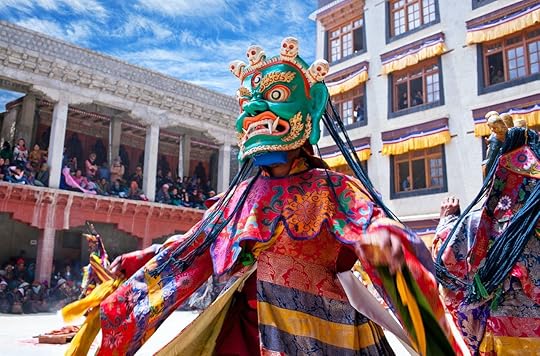
Photo: Zzvet/Shutterstock
During Gutor (the two days leading up to the new year), families prepare by cleaning their homes to sweep away the previous year’s negativity and get ready to start anew. They may also light up torches and firecrackers to scare off demons, and visit monasteries to send their respects to lamas. In another show of banishing malevolent spirits, monks don elaborate folk costumes and frightening masks to perform plays in temple courtyards. These performances, also known as cham, are complete with dancing, chanting, loud horns, booming drums, and crashing cymbals as the monks act out scenes of good defeating evil.
A fun New Year’s Eve tradition is eating guthuk, a type of dumpling soup. The soup contains as many dumplings as there are people eating, so each person around the table gets one. Dumplings are stuffed with various fillings, each bearing different meanings. It’s a lighthearted game of divination. For example, if you find white-colored fillings in your dumpling, good luck is in your future. If you bite into a chili, it means you have a sharp tongue.
Throughout the festival, it’s also popular for Tibetans to enjoy yak butter tea, khapsé (deep-fried pastry twists), and homemade chang (a warming alcoholic drink made of barley, rice, or millet).

Photo: Alen thien/Shutterstock
On the first day of Losar, Tibetans rise early, put on new or freshly washed clothes, and spend the day at home with their immediate family. Housewives wake up especially early to make barley wine and carry on the tradition of collecting water from the nearest well or river. As the first of the year, this water is seen as exceptionally pure, and it’s said that the first family to fetch it will enjoy luck for the coming year. On this day, Tibetan families also worship at their household altars, exchange gifts, and feast together.
The second day is the time to visit friends and relatives. Upon entering a home, guests approach the chemar bo that the host has set up on their altar. A chemar bo is a wooden box split into two sections with chemar (a mixture of roasted barley flour and butter) in one half and roasted barley grains in the other. Butter sculptures and other decorations color the box. Guests take a pinch of the chemar and offer blessings of happiness to the host with a friendly “Tashi delek!” (“Happy New Year!”) They then wave their hands three times and toss the chemar in the air. After, hosts and guests spend time together socializing, eating, and playing games.
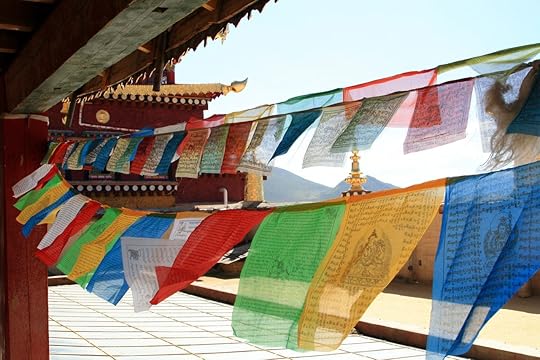
Photo: Jakrit Jiraratwaro/Shutterstock
The third day of Losar is reserved for worship and prayer, paying respect and spreading blessings not only to deities and lamas but also neighbors and people in general. At home, old prayer flags are replaced with new ones. These flags are colorful squares of cloth bearing written prayers and mantras. Tibetans believe that the prayers can be carried through the wind, and anyone who crosses paths with this wind becomes blessed with the intentions it holds. The smell of herbal incense is strong on the third day as it is traditional to perform lhasang (incense offering) ceremonies, which purify the air of negative energy and invite higher beings down to earth, bringing abundant blessings with them. After these ceremonies, people recite chants and splash tsampa (roasted barley flour) into the air, believed to release prosperity and health into the world.
Butter sculptures and the Butter Lamp Festival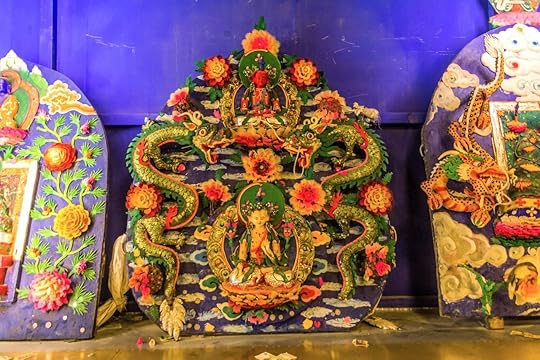
Photo: Matyas Rehak/Shutterstock
Perhaps the most eye-catching aspect of Losar is the hundreds of colorful butter sculptures that decorate home altars and monasteries as offerings. Made primarily by monks and nuns, these sculptures vary in size from a few short centimeters to several towering feet, and they can get very intricate. The sculptures are made of pigments mixed with dri (or female yak butter), which is easy to obtain and malleable. But as malleable as the material is, this unique artwork is not easy to make and requires a lot of skill, practice, and devotion. Cold temperatures are needed to keep the butter from melting as artists work with the material by hand.
The butter sculptures, or tormas, can be shaped into anything and vary in shapes. Some common figures include Buddha, flowers, animals, and other natural and religious symbols.
Butter sculptures have become a sacred art and a unique way to adorn altars. They also serve as a reminder of the Buddhist philosophy that nothing is permanent. After the Butter Lamp Festival, the sculptures are often taken apart and fed to animals.
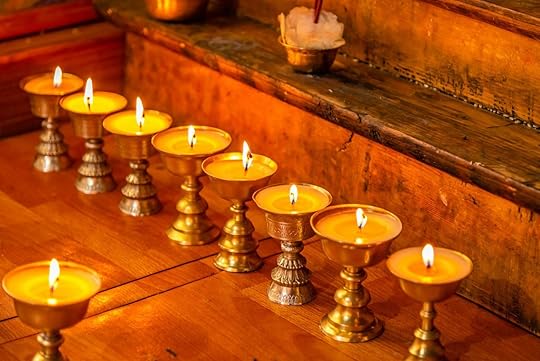
Photo: Amit kg/Shutterstock
Along with the sculptures, lamps made of clarified yak butter are lit on the night of the festival’s final day. This is the 15th night of the New Year celebrations, a night when the full moon is always shining. The Butter Lamp Festival, or Chunga Choepa, is one of four Buddhist festivals that honor major events in the Buddha’s life. This one commemorates the Buddha’s victory over his opponents in a great debate and marks the end of Losar. It’s a dazzling display of twinkling lanterns that range in size and shape. 
The post In Tibet, New Year is celebrated with barley, dumpling soup, and a lot of yak butter appeared first on Matador Network.

Resorts in Hawaii offer free stays

You don’t usually get money-back guarantees on your vacations, but extra reassurances are all the rage traveling during the COVID-19 era. Outrigger Hotels and Resorts is guaranteeing that you’ll enjoy your stay at one of their properties in Hawaii, and if you don’t, you’ll get another for free.
The Outrigger Promise announced on February 4 states that “guests will love their Hawaii holiday at Outrigger, and if not — the premier beach resort brand will credit the guest for a future stay, on the house.’
Sean Dee, EVP and Chief Marketing Officer for Outrigger Hospitality Group, said in a statement, “Now that the State of Hawaii Safe Travels protocols are in place, vaccines are becoming available, and hope is on the horizon, The Outrigger Promise further inspires travelers to make meaningful memories in one of the most naturally beautiful and culturally rich places on earth. Here at Outrigger in Waikiki, we’re confident that visitors will love their Hawaii vacation with us — if they don’t, we’ll credit them a future stay. Promise.”
The Outrigger Waikiki Beach Resort and Waikiki Beachcomber By Outrigger properties are both participating in the promotion. To be eligible, you’ll have to book a minimum of four nights at either participating hotel between February 4, 2021, and May 1, 2021, for a stay between March 1, 2021, and December 21, 2021. And presumably, you’ll also have to have a bad time.
To receive credit for a future stay, call an Outrigger representative at 1-866-256-8461 before December 21, 2021. You will be given a free stay at the same property for no more than the original number of days stayed (up to 14 days). You’ll have until December 21, 2022, to use the redemption. 
The post These resorts in Hawaii will give you a free stay if you don’t enjoy your vacation appeared first on Matador Network.

Matador Network's Blog
- Matador Network's profile
- 6 followers



